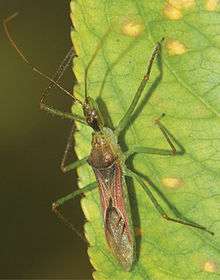Zelus (genus)
| Zelus | |
|---|---|
 | |
| Zelus renardii | |
| Scientific classification | |
| Kingdom: | Animalia |
| Phylum: | Arthropoda |
| Class: | Insecta |
| Order: | Hemiptera |
| Suborder: | Heteroptera |
| Infraorder: | Cimicomorpha |
| Superfamily: | Reduvioidea |
| Family: | Reduviidae |
| Subfamily: | Harpactorinae |
| Tribe: | Harpactorini |
| Genus: | Zelus Fabricus, 1803 |
| Species | |
|
About 60, see text | |
Zelus is a genus of insects in the family Reduviidae, the assassin bugs. There are currently 60 described species; most occur in Central and South America, and five are found in North America.[1]
Some species have been investigated for their potential as biocontrol agents in integrated pest management. Zelus is also known for a sticky trap predation strategy. Sticky resin produced from a leg gland is smeared on hairs to aid in prey capture. This is somewhat analogous to the carnivorous plant sundew.
Species include:
- Zelus annulosus
- Zelus araneiformis Haviland
- Zelus cervicalis
- Zelus exsanguis
- Zelus leucogrammus (Perty, 1833)
- Zelus longipes – milkweed assassin bug
- Zelus luridus Stål, 1862 – pale green assassin bug
- Zelus renardii – leafhopper assassin bug
- Zelus tetracanthus Stål, 1862
References
| Wikimedia Commons has media related to Zelus. |
- ↑ Taxonomic Revision of Zelus Fabricius. Heteropteran Systematics Lab. University of California, Riverside.
External links
- "Genus Zelus". Retrieved 2008-09-14.
This article is issued from Wikipedia - version of the 7/28/2016. The text is available under the Creative Commons Attribution/Share Alike but additional terms may apply for the media files.